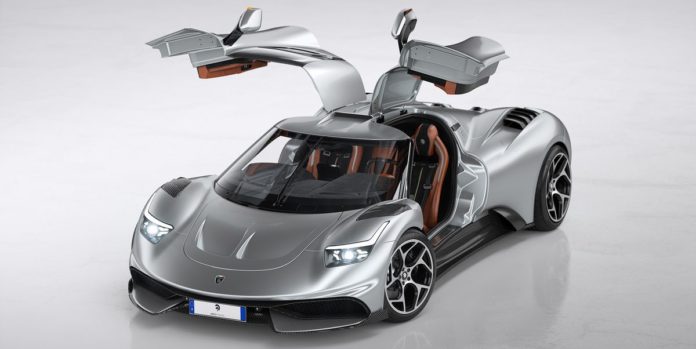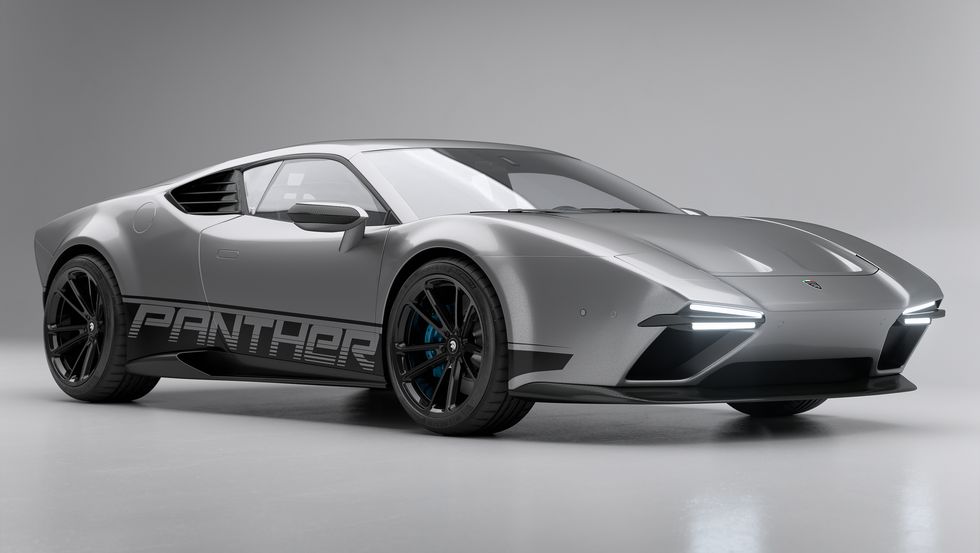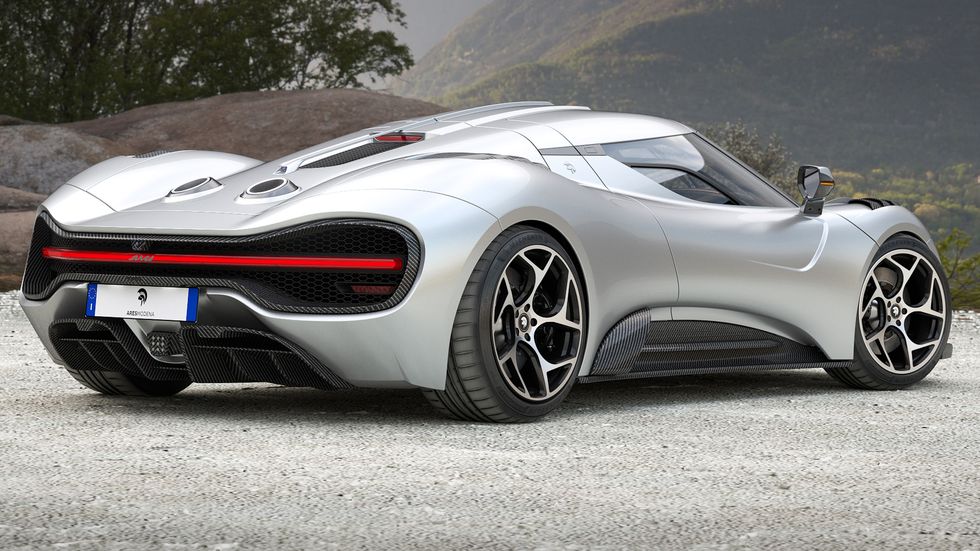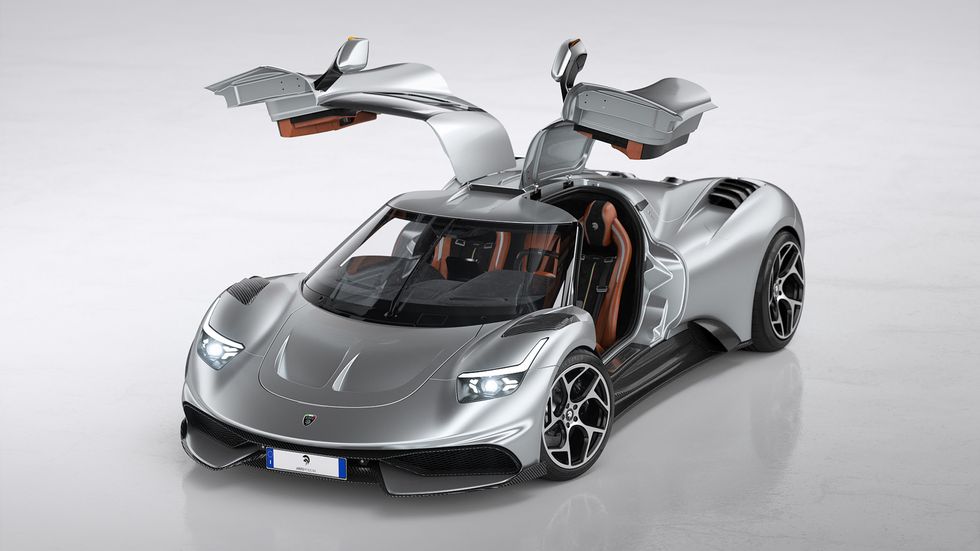- There’s a history in Italy of firms such as Scaglietti and Pininfarina rebodying Corvettes, and Ares of Modena is the latest, using a C8 to create the S1 coupe.
- Ares has been around since 2014 and has previously created limited-edition cars based on vehicles from Bentley, Land Rover, Mercedes, Porsche—even Tesla.
- The Ares S1 will be built in a limited edition of 24.
Many of the most exotic car brands have origin stories of passion-wracked artisans laboring to achieve automotive perfection. But there has always been a strong element of both brutality and butchery to hand-built carmaking, especially when an existing car must shed one set of bodywork in order to receive another. Which is why the brand-new C8 Corvette Stingray parked at one end of the gleaming Ares factory in Modena, Italy, on the day of our visit is as doomed as a pig standing next to a slaughterhouse.
Probably fortunately, we didn’t experience the emotional trauma of seeing and hearing the air chisels at work. Ares is building just two dozen of the C8 Corvette–based S1 coupe, so the cars move with bureaucratic slowness through the factory.
Our visit offered a straight before-and-after juxtaposition. On one side: a gleaming red Stingray with the Z51 performance pack, seats still wrapped in protective plastic and looking ready to become somebody’s dream car. On the other: a literal cutaway, the previous Vette in line having been reduced to its core structure of floor, firewall, and chassis, although with engine and suspension components still in place, its sawn-off A-pillars raised like stubby fists appealing for justice.
Ares does sell the salvageable components to reduce costs; if you’re looking for a C8 headlight or door mirror in Italy, they must be the go-to guys. It still feels like an act of sacrilege.
Yet it’s an idea with a long history. The idea of a rebodied Corvette has been around for nearly as long as the Corvette, with some of the finest having come from Italy. In 1959, Carroll Shelby, and fellow Texan racers Jim Hall and Gary Laughlin arranged to have a three naked C1 chassis shipped across the Atlantic to Carrozzeria Scaglietti, the famous body shop sending back a trio of Ferrari-like coupes. In 1963, General Motors went as far as commissioning Pininfarina to rebody a C2 to look more European; the elegant restyling was done by a young Tom Tjaarda, although the car remained a one-off.
Dany Bahar, Ex-Lotus, Is Ares’s Founder
You might not have heard of Ares, but you’ll probably recognize the name of its founder. Dany Bahar is the Turkish-Swiss onetime boss of Lotus, whose tenure at the British sports-car maker will forever carry the descriptor “controversial.” Bahar was the man behind Lotus’s presentation of no fewer than five new models at the 2010 Paris auto show, none of which ever made production, and his reign came to an acrimonious end in 2012. Bahar and Lotus subsequently sued each other after he had been fired, but a settlement was reached before either case got to trial.
“I learned a lot from that time,” admits Bahar when we speak in his enormous office. He is fractionally grayer but still looks remarkably youthful for somebody approaching his 52nd birthday. “I learned that words are not worth anything in the corporate world, that everything needs to be in writing.”
Bahar established Ares in 2014 in Modena with business partner Waleed Al Ghafari. It was started as an upmarket modification business to help the wealthy realize outlandish dreams, initially doing work similar to companies such as Mansory that have long counted on the cash-rich, taste-poor demographic. But Ares quickly moved beyond paint, trim, and outrageous body kits. It began undertaking more substantial modifications, creating limited runs of models but keeping the core mechanical components of the cars they were based on.
These have included a targa version of the Porsche 911 GT3 and a two-door Bentley Mulsanne coupe which, when seen up close, really does feel indistinguishable from a factory-built car. There have been butched-up versions of both the classic Land Rover Defender and Mercedes G-class, and even cabriolet and station wagon conversions of the Tesla Model S. Bahar admits to finding it difficult to say no to customer requests.
Panther Project One
The most spectacular early project was the Panther ProgettoUno (“Project One”) a Lamborghini Huracán transformed into what is effectively a modern take on the De Tomaso Pantera. This features the option of an H-pattern gear shifter to control its dual-clutch gearbox, although sadly not one that replicates a manual—instead it just assigns Park, Reverse, Neutral, Drive and manual up/downshift to the different positions.
But the Ares S1 is much more ambitious, with a run of coupes to be followed by roadsters, and serious work is necessary to transform the American sports car into a pseudo-hypercar. The assembly bays in Modena show the process: After the C8 is shorn of its bodywork, a new metal sub-structure is added, and carbon-fiber panels are affixed. The regular C8’s doors are replaced with butterfly hinged units (a hypercar must), and the cabin is redesigned and re-trimmed. One of the S1’s most striking design details is the exhausts that exit through the engine’s top cover, something that required significant re-plumbing in the engine compartment.
You may be feeling cynical, but the S1 has genuine superstar presence. Up close, it looks like a million dollars. Which is fortunate, because it costs slightly more than that. There was an artful inexactitude on pricing among the Ares employees we spoke to. The S1 can be subjected to the sort of bespoke customization that gets buyers striving for unique Pantone numbers and rare animal skins. But the guide is a million Euro to start, so just over $1 million.
Some good news: As the S1 is based on an existing car, it bypasses many of the type-approval pitfalls that often snare limited-run performance cars. We’re told several S1s already have been sold to buyers in the States.
The Design Just Works
Even knowing there’s a Corvette underneath, the S1 still works as a piece of design. The regular C8 can feel like a reluctant alliance of lines and angles, none of which hide the car’s big bones. But Ares has managed to wrap the same hard points in sleek, muscular curves that both seem to reference numerous supercars while still appearing fresh and original.
The swoopy new exterior has brought significant compromises, though, the most obvious from the moment you try to access the S1’s cabin. For anybody much over six feet in height, this will likely be a short skirmish followed by surrender—they simply will not fit. As an on-the-line six-footer, your reporter found it necessary to move the driver’s seat into its lowest and most reclined position just to get my upper body in, and that still left my hair touching the roof once the heavy door was pulled closed. The seats have been retrimmed and given Ares logos, but the original Corvette frames sit underneath. The company says it is working on a much-needed lowering kit.
It feels like trying to drive a luxurious pillbox, with a rearview camera system in lieu of any glass at the back; its image appears on the new center screen. The S1’s cabin loses the mountainous ridge of switchgear that separates driver and passenger in the C8, and it also has a wholly revised digital instrument cluster. Among the finely stitched leather there are still plenty of recognizable Corvette parts, including the transmission controls and steering wheel, the latter recovered and bearing the Ares Trojan helmet logo.
There is also theater. There’s a digital display in front of the passenger, a feature inspired by bluer-blooded supercars such as the Ferrari 296GTB and Lamborghini Revuelto. In the S1 demonstrator, one of these digital bars reporting on dynamic status was marked “4WS,” which was surprising because the C8 doesn’t have four-wheel steering, and therefore neither does the Ares.
Mechanical changes are very slight. When the car was first announced, Ares claimed it would make 715 horsepower, but that number has since been reduced to a considerably less thrilling 530 horsepower, which is just 35 hp more than the regular Stingray—attributable to a new ECU and the freer-flowing exhaust. More significant is the claimed 550-pound weight loss thanks to the carbon-fiber bodywork. Despite that, the engineering team said the suspension components and most settings are unchanged beyond geometry tweaks. (All S1 donor Stingrays have both the Z51 package and optional magnetorheological adaptive dampers.)
As a car designed explicitly for those prioritizing show over go, the S1’s driving experience is every bit as good as it needs to be. But it’s also not especially good. The Ares is noticeably less composed than the regular C8, with the combination of weight savings and the unchanged suspension meaning it now feels stiff and overdamped at lower speeds. Even with the adaptive dampers in their softest setting—the original Tour mode has been given an Italian rebranding as Strada—there is still noticeable upward deflection over bumps the regular Stingray would be able to digest using its suspension travel. The S1’s steering has become more anemic, too—still fast geared and delivering keen front end responses, but light and devoid of sensation.
Feels More Potent Than the Corvette
There are pluses. The improved power-to-weight ratio means the S1 feels more potent than the Corvette, especially when asked to accelerate from low revs. The new exhaust delivers a raspy soundtrack when pushed hard, but not an especially loud one. Not that it can be pushed any harder than the Stingray, with the pushrod LT2’s unchanged 6500-rpm redline definitely unworthy of something trying to look like an unobtainium-grade hypercar.
Yet Ares possesses a refreshing honesty about both its cars and its customers. “Our customers rarely ask ‘How much?'” says Bahar. “It is a question that doesn’t apply . . . We are never selling a first car, we are selling to people who typically own 20-plus cars. We’re never the main project, never the most important car, we’re an add-on, something completely different—the last child, if you will.”
Cynics might see a car targeting people who already have so many real supercars that now they want a fake one, but Bahar is right that exclusivity is a powerful force at the sharpest end of the car market.
Ferrari is set to make nearly 1400 of its limited-run SF90 between coupe and spider versions, volumes that make a real risk that buyers will face the indignity of ultimately having to park next to another example.
It is hard to imagine any Ares S1 suffering that fate.
Senior European Correspondent
Our man on the other side of the pond, Mike Duff lives in Britain but reports from across Europe, sometimes beyond. He has previously held staff roles on U.K. titles including CAR, Autocar, and evo, but his own automotive tastes tend toward the Germanic: he owns both a troublesome 987-generation Porsche Cayman S and a Mercedes 190E 2.5-16.






